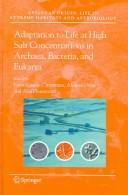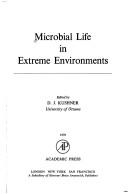| Listing 1 - 4 of 4 |
Sort by
|

ISBN: 1280412542 9786610412549 1402036337 1402036329 9048169143 Year: 2005 Publisher: Dordrecht : Springer,
Abstract | Keywords | Export | Availability | Bookmark
 Loading...
Loading...Choose an application
- Reference Manager
- EndNote
- RefWorks (Direct export to RefWorks)
Salt is an essential requirement of life. Already from ancient times (e. g. , see the books of the Bible) its importance in human life has been known. For example, salt symbolizes destruction (as in Sodom and Gomorra), but on the other hand it has been an ingredient of every sacrifice during the Holy Temple periods. Microbial life in concentrated salt solutions has fascinated scientists since its discovery. Recently there have been several international meetings and books devoted entirely to halophiles. This book includes the proceedings of the “Halophiles 2004” conference held in Ljubljana, Slovenia, in September 2004 (www. u- lj. si/~bfbhaloph/index. html). This meeting was attended by 120 participants from 25 countries. The editors have selected presentations given at the meeting for this volume, and have also invited a number of contributions from experts who had not been present in Ljubljana. This book complements “Halophilic Microorganisms”, edited by A. Ventosa and published by Springer-Verlag (2004), “Halophilic Microorganism and their Environments” by A. Oren (2002), published by Kluwer Academic Publishers as volume 5 of “Cellular Origins, Life in Extreme Habitats and Astrobiology” (COLE), and “Microbiology and Biogeochemistry of Hypersaline Environments” edited by A. Oren, and published by CRC Press, Boca Raton (1999). Salt-loving (halophilic) microorganisms grow in salt solutions above seawater salinity (~3. 5% salt) up to saturation ranges (i. e. , around 35% salt). High concentrations of salt occur in natural environments (e. g.
Archaebacteria --- Bacteria --- Eukaryotic cells --- Extreme environments --- Effect of salt on. --- Microbiology. --- Extremophiles (Microbiology) --- Geomicrobiology --- Microbial ecology --- Extremozymes --- Eucaryotic cells --- Cells --- Protista --- Germs --- Microbes --- Prokaryotes --- Archaea --- Archaeobacteria --- Biochemistry. --- Biochemistry, general. --- Biological chemistry --- Chemical composition of organisms --- Organisms --- Physiological chemistry --- Biology --- Chemistry --- Medical sciences --- Microbial biology --- Microorganisms --- Composition

ISBN: 0124302505 Year: 1978 Publisher: London Academic press
Abstract | Keywords | Export | Availability | Bookmark
 Loading...
Loading...Choose an application
- Reference Manager
- EndNote
- RefWorks (Direct export to RefWorks)
General ecology and biosociology --- General microbiology --- Adaptation, Psychological --- Bacteria --- Ecology --- Microbiology --- Microorganisms --- Adaptation (Physiology) --- Microbial ecology --- Micro-organismes --- Adaptation (Physiologie) --- Ecologie microbienne --- Physiology --- Physiologie --- 579.26 --- Extreme environments --- -Microbial ecology --- -Germs --- Micro-organisms --- Microbes --- Microscopic organisms --- Organisms --- Environmental microbiology --- Environments, Extreme --- Compensation (Physiology) --- Plasticity (Physiology) --- Ecophysiology --- 579.26 Microbial ecology --- Microbial physiology --- Extremophiles (Microbiology) --- Geomicrobiology --- Extremozymes --- Adaptation, Psychological. --- Bacteria. --- Ecology. --- Microbiology.
Periodical
Abstract | Keywords | Export | Availability | Bookmark
 Loading...
Loading...Choose an application
- Reference Manager
- EndNote
- RefWorks (Direct export to RefWorks)
Adaptation (Biology) --- Extreme environments --- Microbial ecology --- Adaptation (Biologie) --- Milieux extrêmes --- Ecologie microbienne --- Periodicals. --- Microbiology --- Périodiques --- Microbiologie --- Biologie moléculaire --- Extreme environments. --- Agriculture Sciences --- Life Sciences --- Soil Chemistry, Microbiology, Fertility & Fertilizers --- Biology --- Micro and Molecular Biology --- Environment. --- Microbiology. --- Microorganisms --- Adaptation, Biological --- Environment --- Self-organizing systems --- Variation (Biology) --- Biological fitness --- Genetics --- Environmental microbiology --- Ecology --- Environments, Extreme --- Germs --- Micro-organisms --- Microbes --- Microscopic organisms --- Organisms --- Infectious Disease Medicine --- Environmental Impact --- Environmental Impacts --- Impact, Environmental --- Impacts, Environmental --- Environments --- Environmental Health --- Adaptation, Biologic --- Biological Adaptation --- Biologic Adaptation --- Physiology --- Microbial ecology. --- Physiology. --- Extremophiles (Microbiology) --- Geomicrobiology --- Extremozymes --- Microbial physiology --- Journal --- Periodicals --- Adaptation, Biological. --- Environmental adaptation --- Adaptation, Environmental
Book
ISBN: 1281133671 9786611133672 3540743359 Year: 2008 Publisher: Berlin : Springer,
Abstract | Keywords | Export | Availability | Bookmark
 Loading...
Loading...Choose an application
- Reference Manager
- EndNote
- RefWorks (Direct export to RefWorks)
Most scientists in the middle of the twentieth century would probably not have believed that life was possible at extreme values of environmental factors, such as pH values close to 0 (e. g. sulfurous environments) or to 14 (e. g. soda lakes), sali- ties of 6 M NaCl (e. g. Dead Sea), hydrostatic pressures approaching 0. 1 MPa (deep sea) and temperatures exceeding 100°C (thermal vents or hot springs) or as low as –20°C (e. g. polar regions). Of the current studies on extremophiles, approximately 30,000 articles by the year 2007, almost two-thirds have been performed on org- isms adapted to outstanding temperatures, but much more attention has been paid to thermophiles than to psychrophiles. However, over the past 10 years, scientific publications on cold-adapted microorganisms have increased by a factor of ten. If one considers the extent of cold habitats, psychrophiles, i. e. cold-loving organisms, should largely lead in this comparison with thermophiles because a great proportion of the Earth’s biosphere never reaches temperatures above 5°C. Nearly three-quarters of the Earth is covered by oceans whose deep water masses, irrespective of latitude, are constantly between 2 and 4°C. The large continent of Antarctica also provides a permanently cold terrestrial environment as well as an aquatic niche in the surrounding ice that melts during the summer. Other examples of cold habitats are permafrost soils, high alpine soils, cold deserts, cold caves, marine sediments, snow, glacier and sea ice.
Extreme environments --- Ecology. --- Microbiology. --- Balance of nature --- Biology --- Bionomics --- Ecological processes --- Ecological science --- Ecological sciences --- Environment --- Environmental biology --- Oecology --- Environmental sciences --- Population biology --- Extremophiles (Microbiology) --- Geomicrobiology --- Microbial ecology --- Extremozymes --- Ecology --- Biochemistry. --- Biotechnology. --- Microbial genetics. --- Microbial genomics. --- Microbial ecology. --- Biochemistry, general. --- Microbial Genetics and Genomics. --- Microbial Ecology. --- Applied Microbiology. --- Astrophysics and Astroparticles. --- Microbial biology --- Microorganisms --- Environmental microbiology --- Microbiology --- Genomics --- Microbial genetics --- Genetics --- Chemical engineering --- Genetic engineering --- Biological chemistry --- Chemical composition of organisms --- Organisms --- Physiological chemistry --- Chemistry --- Medical sciences --- Composition --- Astrophysics. --- Astronomical physics --- Astronomy --- Cosmic physics --- Physics
| Listing 1 - 4 of 4 |
Sort by
|

 Search
Search Feedback
Feedback About UniCat
About UniCat  Help
Help News
News